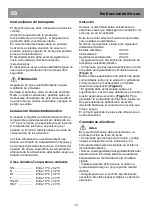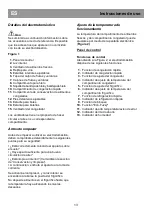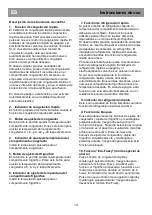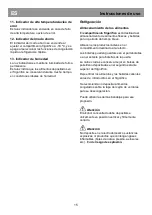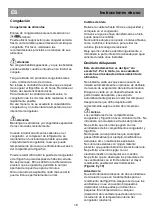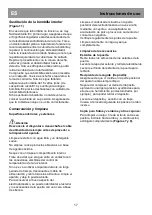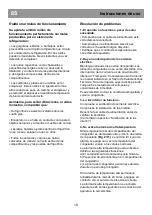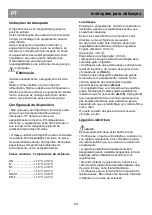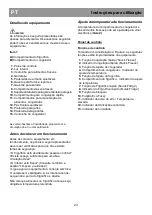
Freezing
• Always leave food to thaw in a container that
allows the thawing water to run off.
• Do not exceed the maximum allowable freezing
capacity when freezing fresh food (see the section
"Freezing")
• Do not give children ice-cream and water ices
direct from the freezer.
The low temperature may cause freeze burns on
lips.
• Never re-freeze defrosted food; defrosted food
must be consumed within 24 hours. Only food that
has been cooked can be refrozen.
• Do not take out frozen food with wet hands.
• Store only fresh and impeccable food.
• Always use appropriate packaging material to
avoid odour penetration or degradation of the
food.
• Store commercially frozen food in accordance
with the instructions given on the packaging.
• Freeze cooked food in small quantities. This
ensures rapid freezing and maintains the quality of
the food.
• Do not freeze liquid in tightly closed bottles or
containers.
The bottles/containers may burst at low
temperatures.
• Carry pre-frozen food in suitable bags and place
it in your freezer as soon as possible.
Always defrost food in the fridge compartment.
8
Examples of Use
White wine, beer and mineral water
chill before use
Bananas
do not store in a fridge
Fish or offal
store in polyethylene bags only
Cheese
use airtight containers or polyethylene
bags; for best results, take out from the
fridge an hour before consumption.
Melons
store only for a short period of time,
use airtight packaging/wrapping
Raw meat and poultry
do not store together with delicate
food such as cooked food or milk
Normal operating noises
Various functional noises are completely
normal due to the operation of the cooling
system of your appliance;
• Gurgling, hissing, boiling or bubbling noises are
caused by the refrigerant, circulating inside the
cooling system. These noises can still be heard for
a short period of time after the compressor shuts
off.
• Sudden, sharp cracking or popping noises are
caused by the expansion and contraction of the
inside walls or some components inside the
cabinets.
• Buzzing, whirring, pulsating or high-pitched
humming noises are caused by the compressor.
These noises are slightly louder at the start-up of
the compressor and reduce when the appliance
reaches the operating temperatures.
Also to avoid disturbing vibrations and
noises make sure that;
• Your refrigerator is standing level on all four feet.
• Your refrigerator is not in contact with the walls,
surrounding objects or kitchen cabinets and
furniture.
• Cans, bottles or dishes inside the refrigerator are
not touching and rattling against each other.
• All shelves and bins are mounted correctly inside
the refrigerator cabinets and doors.
GB
Instruction for use
Содержание CT2004NFI
Страница 1: ...GB Instruction for use ES Instrucciones para el uso PT Manual de Instruções CT2004NFI ...
Страница 4: ...2 1 ...
Страница 5: ...3 4 5 8 6 7 9 11 10 ...
Страница 36: ...4578331672 29 05 2014 ...

















